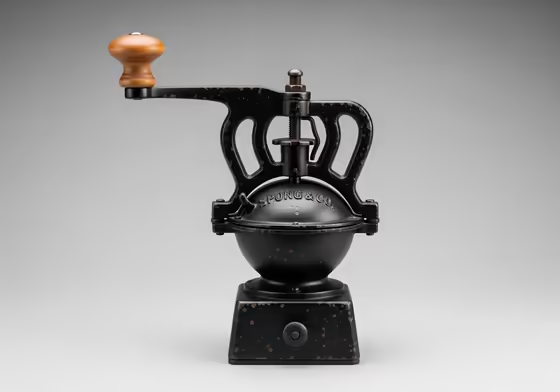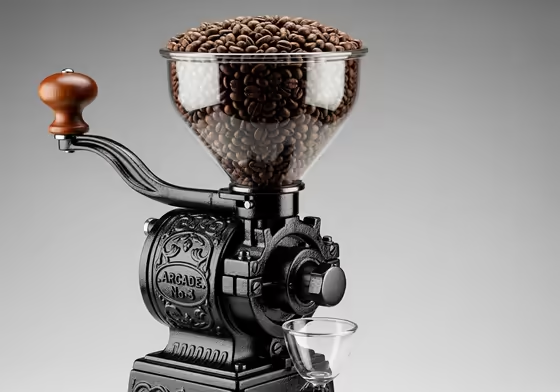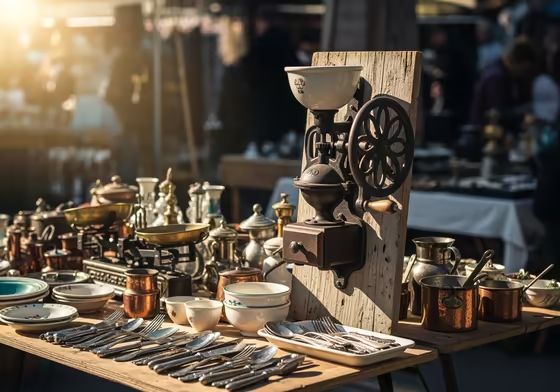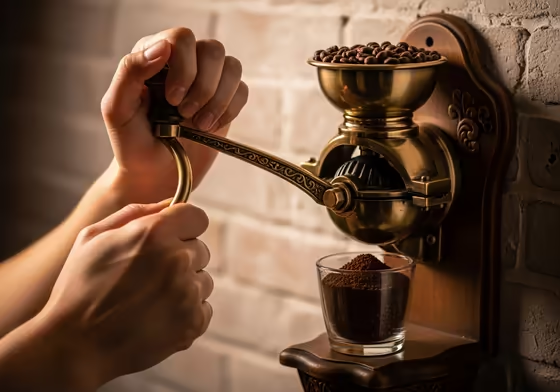A Guide to Wall-Mounted Coffee Grinders
A wall-mounted coffee grinder is a tool from the past that still works today. It's more than just a kitchen gadget. It connects us to a time when making coffee was a hands-on process.

These grinders are great for saving space. Since they attach to the wall, they don't clutter up your countertop. This helps keep your kitchen organized and leaves more room for other things.
Wall grinders also look great, especially in rustic or vintage-style kitchens. They can be a fun conversation starter. It's an old design that solves the modern problem of too many appliances.
Different Kinds of Wall Grinders
The first patent for a wall-mounted coffee mill was in 1798. They became common in kitchens from the late 1800s to the 1970s. You can find them made from cast iron, ceramic, and wood.

You'll hear words like manual , cast iron , and vintage used to describe these grinders. These are just different ways to talk about the same item. For example, a single grinder can be vintage, cast iron, and manual all at once.
How Manual Grinders Work
Almost all wall-mounted grinders are manual, which means you turn a crank by hand. They use a burr grinding system . This is much better than the blade system in many cheap electric grinders.
The type of grinder really affects your coffee's taste.
- Burr Grinders: These use two rough surfaces to crush coffee beans to a uniform size. This even grind helps pull the best flavor from the beans.
- Blade Grinders: These use a spinning blade to chop up beans, like a blender. The pieces are all different sizes. This leads to a bitter or sour taste in your coffee.
Here's the thing. A 100-year-old wall grinder with burrs can make better tasting coffee than a new, cheap blade grinder.
Heavy-Duty Cast Iron Grinders
Cast iron grinders are the workhorses of the group. They are made of solid metal and were built to last forever. Many still work perfectly today.

They usually have a strong cast-iron body and four holes for mounting securely to a wall. The crank handle often has a wooden knob for a comfortable grip. A good example is the English Spong & Co. grinder.
Classic Vintage Grinders
This is the style you'll see most often in old kitchens from Europe. They are usually made from a mix of materials. They have a wooden board, a ceramic hopper for beans, and a glass cup to catch the grounds.

The ceramic bean hopper is what makes them stand out. Many were painted with blue and white designs, like windmills or flowers. They were both a tool and a piece of kitchen decor.
Some of the key makers of this style were:
- Zassenhaus: A German brand known for making high-quality grinders.
- Peugeot: A French company that made many popular wall-mounted models.
- Douwe Egberts: A Dutch coffee company that sold many grinders with the famous blue "DE" logo.
Arcade: A Famous American Brand
The Arcade Manufacturing Company in Illinois was one of the most famous American makers of wall grinders. They made cast-iron goods from 1885 until the 1930s. Their coffee mills are well-known.

Arcade's most popular models were from their "Crystal" line. These were special because they used a glass hopper for the beans. This let you see how many beans were left inside.
These grinders have a few distinct features:
- A decorative cast-iron body.
- A wooden handle on the crank.
- A clear glass hopper on top for the beans.
- A small glass cup at the bottom to catch the grounds.
The Arcade No. 3 model from around 1900 is famous for its fancy cast-iron design. Arcade also made other models like the "X-Ray".
Finding the Best Wall Grinder
You can't just go to a store and buy the "best" wall grinder new. Finding a good one means you'll be looking for a vintage model. It's a bit of a hunt.
If you just want the best grind quality, today's electric countertop grinders are better. Brands like Baratza, Fellow, and Breville are top choices. But none of them mount to the wall.
Many new wall-mounted grinders you can buy today are just for decoration. They are not made for actual use. An example is the Polish Pottery grinder, which looks nice but isn't meant for grinding coffee.
So if you want a wall grinder that actually works well, your best bet is a restored antique. The best choice depends on what you care about most.
- Best for Grind Quality: A vintage Zassenhaus. This German brand is known for its excellent burrs and solid build.
- Best for Durability: A Spong & Co. or a similar English cast-iron model. These things are nearly indestructible and great for everyday use.
- Best for Looks & History: An Arcade Crystal or X-Ray. These American grinders look beautiful, work well when restored, and are a cool piece of history.
How to Buy a Vintage Grinder
Getting a working wall-mounted coffee grinder is like going on a treasure hunt. Here is a guide on where to look and what to look for.
Where to Look
You can find these grinders almost only on the secondhand market.
- Online Markets: Etsy and eBay are the best places to start, with hundreds of listings.
- Local Shops: Antique dealers, vintage kitchen stores, and local flea markets are also great spots to check.

Prices can be all over the place. A simple model with missing parts might be under $50. A rare and complete Arcade Crystal grinder could cost $200, $400, or even more.
Before you buy, you need to check it carefully. Here are the key things to look for:
- Completeness: Are all the parts there? The most common missing part is the glass catch cup. A grinder with missing original parts is not as valuable or useful.
- Burr Condition: If you can, feel the burrs. They should be sharp, not chipped or worn down from years of use.
- Wood and Metal Condition: Check for mold on any wooden parts. Look for rust on the metal. A little surface rust is okay, but deep, flaky rust is a bigger problem.
- Glass Condition: Look closely at any glass parts for cracks, chips, or stress lines.
Is It Safe to Use an Old Grinder?
This is a very important question. If you buy a grinder from a flea market, the answer is no. It is not safe to use without a deep, food-safe cleaning.
Using a vintage grinder "as-is" can be risky. They were made before modern food safety rules and have often been stored in garages or basements for decades.
- Risk 1: Lead Paint: This is the biggest danger. Most of these grinders were made when lead paint was common. Grinding can cause tiny paint chips to flake off into your coffee grounds.
- Risk 2: Rust: The cast-iron parts are often rusty. While a little rust won't hurt you, flaky rust can hold bacteria and will make your coffee taste bad.
- Risk 3: Old Oils and Mold: Wood soaks up smells and oils. The wooden parts have had years to absorb old coffee oils that are now rancid. The inside is often full of old, moldy coffee grounds.
Because of these dangers, you must restore the grinder before you use it to make coffee.
How to Restore Your Grinder
This guide will show you how to restore an old grinder. This will turn a beautiful but unsafe antique into a kitchen tool you can use every day.
Finding Replacement Parts
The hardest part of restoration is finding original parts that are missing. The glass catch cups and hoppers are broken most often. They are fragile but needed for the grinder to work.
Because original parts for grinders like the Arcade are so rare, some people make reproductions. It is important to know how to tell an original from a fake.
Here's how to spot a reproduction Arcade glass part:
-
Arcade No. 3 Hopper (Top Glass):
- Black Light Test: Original jars glow yellow-green under a black light. Reproductions do not.
- Color: Originals are clear glass. Reproductions often have a light blue or aqua tint.
- Weight: Originals are light (about 17 oz). Reproductions are much heavier (about 32 oz).
- Threads: Originals have smooth threads. Reproductions have a noticeable break in the threads.
-
Arcade No. 4 Catch Cup (Bottom Glass):
- Bottom Lettering: Originals say "FREEPORT ILL" on the bottom. Reproductions are missing this.
- Side Markings: Reproductions often have incorrect markings. They might say "TABLESPOONS" but have lines for ounces.
You can sometimes find missing metal parts by buying another broken grinder for parts online. Some people even 3D print replacements for lids or other simple parts.
A Step-by-Step Restoration Guide
Restoring a grinder can be a fun project. It involves taking it apart and cleaning every piece to make it safe for food.

-
Step 1: Complete Disassembly
Take the entire grinder apart, piece by piece. Take photos as you go so you remember how to put it back together. The goal is to separate all the wood, glass, and metal parts. -
Step 2: Cleaning and Stripping
- Painted Metal: Assume all paint contains lead. Do not sand it , as this creates toxic dust. Use a chemical paint stripper in a place with good airflow.
- Wood: Scrub the wooden parts with hot water and soap. You can also use a cleaner made for coffee equipment to remove the old, stinky oils.
- Grinding Mechanism: Soak all the metal grinding parts in a coffee cleaning solution. This will break down the hardened old coffee gunk.
-
Step 3: Rust Removal (Burrs & Metal Parts)
The burrs must be completely free of rust. There are several food-safe ways to do this.
| Method | Process | Analysis |
|---|---|---|
| White Vinegar Soak | Submerge parts in undiluted white vinegar for 30 minutes to 24 hours.[62, 63] | Pro: Highly effective; rust will "completely wipe away".[62, 64] Con: Soaking too long can etch the metal. A 30-minute soak followed by scrubbing is a safer approach.[65] |
| Lemon/Salt Paste | Create a thick paste of salt (abrasive) and lemon juice (acidic); scrub with a brush.[66, 67] | Pro: Good for targeted application on surface rust. Con: Requires significant scrubbing ("elbow grease").[68] May be ineffective on heavy, pitted rust.[69] |
| Baking Soda Paste | Mix baking soda and water into a paste; scrub.[66] | Pro: Very safe and mildly abrasive. Con: Unlikely to be effective for anything beyond the lightest surface rust. |
| Commercial Remover | Use a non-acidic, food-safe chelating agent like Evapo-Rust.[70] | Pro: Very effective, non-toxic, and will not harm the underlying intact metal.[70] Con: More expensive than household options. |
After removing the rust, you must immediately rinse and dry the parts. Then, coat them with a thin layer of food-safe oil, like mineral oil. This will keep them from rusting again right away.
-
Step 4: Wood Restoration (Food-Safe Finishing)
After the wood is clean and dry, it needs to be sealed. Using the right finish is important to keep it food-safe and prevent bad flavors.
| Finish Type | Examples | Analysis |
|---|---|---|
| Non-Drying Oil | Food-Grade Mineral Oil [72, 73] | Pro: 100% food-safe, flavorless, colorless, and will not go rancid .[73, 74] Con: Never "cures" or hardens.[74] Requires regular re-application to maintain the finish.[75] |
| Wax | Beeswax, Carnauba Wax [74, 76] | Pro: Food-safe, provides a nice polish. Con: Low durability; can wear off quickly.[74] Best used with mineral oil as a board cream. |
| Curing Oils | Pure Tung Oil [76], Refined Walnut Oil [77] | Pro: Penetrates and hardens (cures) in the wood, creating a durable, long-lasting finish.[77] Con: Longer curing time.[77] Walnut oil poses a risk for those with nut allergies. |
| OILS TO AVOID | Vegetable Oils (Olive, Coconut, etc.) | Con: WILL GO RANCID.[77, 78] This will impart a foul, bitter taste and smell to your coffee. |
| OILS TO AVOID | Linseed Oil (Flaxseed) | Con: "Boiled" linseed oil is TOXIC as it contains metallic dryers.[79] "Raw" or "flaxseed" oil will go rancid [74, 80] or impart a bitter taste.[52] |
The best choice for the wooden parts is food-grade mineral oil. After that, you can add a top coat of a beeswax blend. This is safe, reliable, and won't affect the taste of your coffee.
-
Step 5: Reassembly and Calibration
Put the grinder back together carefully. Make sure the burrs are aligned properly so they are centered. Test the handle to make sure everything turns smoothly.
How to Use Your Grinder
-
Daily Operation
- Load your whole coffee beans into the top hopper.
- Make sure the catch cup or drawer is in place.
- Turn the crank handle in a smooth, steady motion.
- The ground coffee will collect in the cup below.

-
How to Adjust the Grind
The grind size is controlled by the distance between the burrs. This is usually changed with a small thumbscrew on the grinding mechanism.- Clockwise for Finer: Turning the screw clockwise moves the burrs closer together. This makes a finer grind, which is good for espresso.
- Counter-Clockwise for Coarser: Turning the screw counter-clockwise moves the burrs farther apart. This makes a coarser grind, which is good for French press.
Here's a tip. If you are making the grind much finer, it is best to turn the handle while you adjust the screw. This helps prevent the beans from jamming the grinder.